The “dogmatic” world record shows the authenticity of Hamadan to the world

The director of Iranology Foundation of Hamadan Province said: “Showing the origin and authenticity of the country is one of the most important benefits of registering historical monuments in the World Heritage List, and the global registration of “Hegmataneh and Historical Center of Hamedan” shows the authenticity of this ancient city to the world. According to Monday’s report from the Public Relations Department of the General Directorate of Cultural Heritage, Tourism and Handicrafts of Hamedan, “Mohsen Janjan” considered the positive economic, social and cultural consequences to be one of the most important benefits of the world registration of “Hegmataneh and the Historical Center of Hamedan” and stated: This is an important event. It will introduce and better identify this historical province to the whole world and will definitely play a significant role in the tourism development of the province.
He emphasized that the global registration will happen with the follow-up of managers and the people’s support, and accurate, correct and timely information about the case process will make all people and people who care about cultural heritage aware of what has happened and will help to persuade public opinion.
The director of Iranology Foundation of Hamedan Province added: Among the other benefits of global registration is the protection of historical context and cultural assets, as well as the development and preservation of the values of the past, traces of which can still be seen in the old city of Hamedan, is one of the blessings of global registration.

Janjan continued: In addition, cultural assets such as language, food and clothing will be preserved by registering the works in the UNESCO world list, and the future generations will be able to know the memories of their ancestors well.
He continued: With globalization, historical monuments are exposed to the eyes of the world and their protection is easier.
In a few weeks, the UNESCO evaluators are going to register Hegmataneh in the UNESCO World Memory by visiting the city of Hamadan and examining the history of this ancient city.
Hegmataneh and the historical center of Hamedan include an area of Hegmataneh ancient site, the city’s central square, the historical market of Hamedan, the tomb of Bu Ali Sina and the historical streets of this area, which is on the threshold of the world registration by UNESCO. The ancient site of Hegmetane dates back to the 17th century BC and was the capital of the first Iranian kings, the Medes.
“Hegmatane and historical center of Hamadan” is considered to be about 100 hectares, which includes Hegmatane hill, bazaar, fabric and 140 historical works. With the global registration of this work, it is expected that the historical fabric, traditional market, Jame Mosque and pedestrian streets of Hamedan city will be preserved. .
Hegmatane historical site with 40 hectares is located at the end of Ekbatan street in Hamedan, this historical hill is attributed to the Medes period and its name is derived from Hegmetane, the capital of the Medes. According to the excavations obtained by some archaeologists, The artefacts discovered in this historical city belong to the Parthian period and the periods after that, of course, some artefacts from the Achaemenid period have also been discovered from this historical site, which indicates the political establishment of the Achaemenid government in Hamedan.
Hegmataneh means “gathering place” and is composed of 2 ancient Persian words “hegmata” which means gathering and the place name suffix “na”.
The time of establishment of the Median government is from 728 BC to 550 BC and although this place is known as the place and capital of the Medes, but so far no strong evidences from this period have been found.
With the discovery of the existing architectural system that belongs to the Parthian period, the date of this city has been assigned to the Parthian period and after.
Buildings with dimensions of 17.5 x 17.5 meters were discovered from the set of exposed buildings, which are located at a depth of 2 to 5 meters from the hill surface.
The existing buildings are built in 2 parallel rows parallel to each other, and between each 2 rows of existing buildings, a 3.5 meter wide passage has been created in the northeast-southwest direction.
Parts of the huge wall of the city with a diameter of approximately 9 meters and a remaining height of eight to 12 meters have also been discovered, which had huge towers at regular intervals.
In the east of the site, the Hegmataneh Museum is located, which houses very valuable works from the pre- and post-Islamic periods.
Hagmetane hosts 2 other historical monuments including “Holy Mary” church and “Gregory Stepanos” church.
Hegmatane historical hill number 28 was registered in the list of national monuments of Iran on 24/06/1310.

